Cortar rollos de césped de gimnasio es sencillo con las herramientas y los pasos adecuados. Mida con precisión, marque claramente, utilice una cuchilla afilada y corte con firmeza para obtener siempre bordes limpios.
Aprendí por las malas que cortar rollos de césped de gimnasio no es sólo cortar material. Se trata de precisión y planificación. Hace años, estropeé un rollo muy caro porque me precipité sin medirlo dos veces. Ahora, sigo un proceso claro: medir desde el reverso, marcar con tiza y usar una cuchilla afilada para hacer cortes limpios. Los distintos tipos de césped, como los de pelo alto o los acolchados, necesitan trucos específicos. Por ejemplo, el césped grueso requiere cortes más lentos. También doy prioridad a la seguridad y uso guantes para manejar las cuchillas afiladas. Tanto si se trata de líneas rectas como de esquinas complicadas, cada paso es importante para evitar desperdicios y conseguir un aspecto profesional. A continuación te explico cómo lo hago, paso a paso, para que tu proyecto de césped brille con luz propia.

Siga leyendo para dominar las herramientas y técnicas para un corte de césped impecable.
¿Qué herramientas son las mejores para cortar rollos de césped de gimnasio?
Lo mejor es utilizar una navaja multiusos, una cuchilla para moquetas o un cúter eléctrico. Combínalos con una cinta métrica y una línea de tiza para conseguir cortes precisos y limpios.
Elegir las herramientas adecuadas
He cortado muchos rollos de césped y las herramientas adecuadas marcan la diferencia. Una navaja multiusos ($5-$20) con una hoja nueva corta limpiamente la mayoría del césped. Las cuchillas para moquetas ($10-$30) aguantan bien los soportes más gruesos. Para trabajos grandes, he utilizado cortadoras rotativas eléctricas ($50-$300), como una Dremel, que ahorran tiempo. Las tijeras para trabajos pesados ($15-$25) sirven para pequeños arreglos de bricolaje. En 2025, las cizallas a pilas están de moda por su portabilidad. En cuanto al presupuesto, una navaja Stanley $15 es adecuada para principiantes, mientras que los profesionales pueden invertir en un cúter Roberts $100. Aquí tienes un desglose:
| Herramienta | Precios | Precisión | Lo mejor para |
|---|---|---|---|
| Cuchillo multiusos | $5-$20 | Alta | Recortes generales |
| Cuchillo para alfombras | $10-$30 | Alta | Césped grueso |
| Cortadora eléctrica | $50-$300 | Medio | Grandes proyectos |
| Tijeras | $15-$25 | Bajo | Pequeñas reparaciones |
Elija lo que se ajuste a su proyecto y presupuesto.
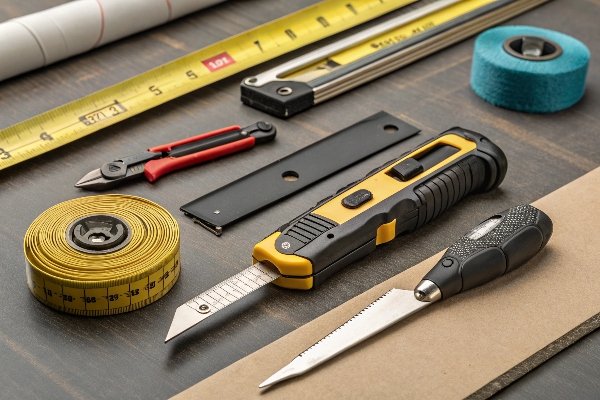
Quédate conmigo para asegurarte de que tus cortes están bien afilados.
¿Cómo se garantiza un corte limpio al recortar el césped de un gimnasio?
Utilice una cuchilla afilada, marque una línea con tiza y corte lentamente. Así evitarás que se deshilache y mantendrás los bordes lisos para un acabado profesional.
Dominar los cortes limpios
Una vez estropeé el borde de un césped con una cuchilla desafilada, nunca más. Una cuchilla afilada es la clave. Yo marco una línea de tiza en el soporte para guiarme y corto con una presión ligera y constante. Para céspedes de pelo alto, hago pasadas poco profundas para evitar desgarrar las fibras. Los céspedes acolchados necesitan una cuchilla de moqueta para un mejor control. Si voy a unir costuras, recorto tres mechones de cada borde para que quede bien ajustado. Sobre hormigón, aseguro el césped para evitar que resbale. Este es mi método:
| Paso | Consejo |
|---|---|
| Afilado de la cuchilla | Cambie las cuchillas cada 10-15 minutos |
| Movimiento de corte | Los tirones lentos y uniformes evitan los enganches |
| Preparación de superficies | Asegure el césped en una superficie estable |
Los cortes limpios hacen que tu césped tenga un aspecto impecable, así que no tengas prisa.
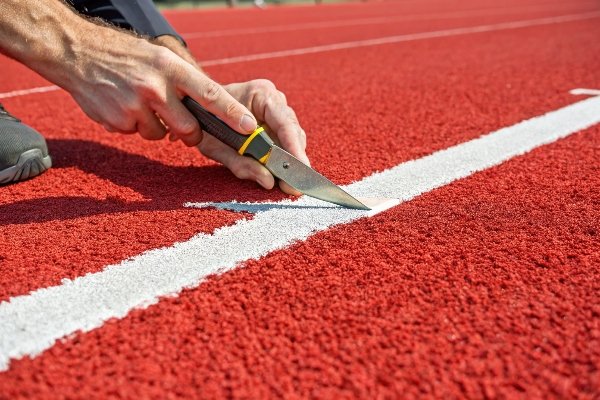
Sigue leyendo para perfeccionar tus medidas.
¿Cuál es la mejor manera de medir y marcar los cortes en los rollos de césped de gimnasio?
Mida desde el reverso con una cinta métrica. Marque ambos lados con tiza y, a continuación, trace una línea recta para cortar.
Medir y marcar con precisión
Yo he hecho cortes erróneos midiendo desde las fibras, gran error. Mide siempre el soporte con una cinta métrica. Marco ambos extremos con tiza o un rotulador, comprobando la alineación. Para cortes rectos, trazo una línea de tiza como guía. Para las curvas, trazo una plantilla de cartón con una regla flexible. En climas húmedos, me aseguro de que el césped esté seco para evitar que se estire. Este es mi proceso:
| Tarea | Buenas prácticas |
|---|---|
| Medición | Usar respaldo, medir dos veces |
| Marcado | Tiza para visibilidad |
| Plantillas | Cartón para curvas o ángulos |
Unas marcas precisas dan lugar a cortes perfectos en todo momento.
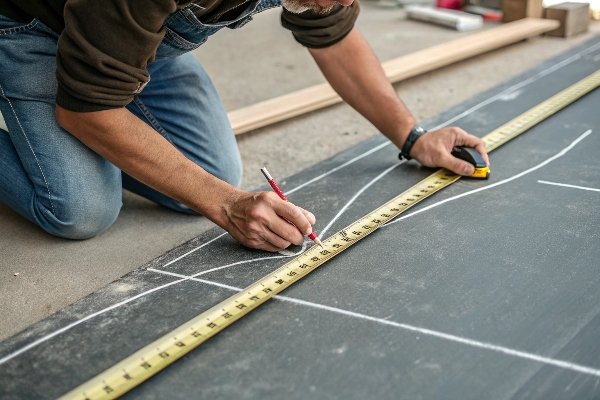
Sigue avanzando para abordar esquinas y bordes.
¿Cómo se gestionan los cortes en esquinas o bordes al recortar el césped de un gimnasio?
Doble el césped hacia atrás, trace una plantilla y corte en pequeñas secciones. Compruebe el ajuste antes de finalizar para obtener bordes sin costuras.
Recortes complejos
Cortar las esquinas solía frustrarme hasta que me volví más inteligente al respecto. Doblo el césped hacia atrás para exponer la zona. Para las curvas, como alrededor de los pilares, trazo una plantilla de cartón. Corto en secciones de 15 cm para mantener la precisión. Cerca de las paredes, recorto los mechones sobrantes para que queden bien ajustados. Para las juntas, superpongo dos piezas, las corto juntas y quito tres mechones de cada borde. En el suelo, primero sujeto el césped con estacas. Este es mi método:
| Zona | Técnica |
|---|---|
| Curvas | Plantilla, cortada en pequeñas secciones |
| Paredes | Doblar hacia atrás, recortar los mechones |
| Costuras | Superponer y cortar ambas piezas |
La paciencia se ve recompensada con unos bordes limpios de nivel profesional.

Quédate conmigo para elegir la longitud correcta de la hoja.
¿Cuál es la longitud de cuchilla recomendada para cortar césped de gimnasio?
Lo ideal es una cuchilla de 4 a 6 pulgadas. Corta el forro con facilidad y mantiene la precisión en la mayoría de los tipos de césped.
Selección de la longitud de la cuchilla
He probado diferentes cuchillas, y de 4 a 6 pulgadas funcionan mejor para el césped de gimnasio. Las cuchillas cortas (2-3 pulgadas), como las X-Acto, son estupendas para los detalles pero lentas para los cortes largos. Las más largas (más de 8 pulgadas) son difíciles de controlar. Una navaja multiusos de 5 pulgadas equilibra potencia y precisión. Para los soportes de poliuretano, utilizo una cuchilla más corta para evitar cortar en exceso. Esto es lo que recomiendo:
| Longitud de la hoja | Mejor uso |
|---|---|
| 2-3 pulgadas | Curvas de precisión, pequeñas correcciones |
| 4-6 pulgadas | Cortes rectos, uso general |
| 8+ pulgadas | Respaldos gruesos, menos precisión |
La cuchilla adecuada hace que el corte sea suave y seguro.
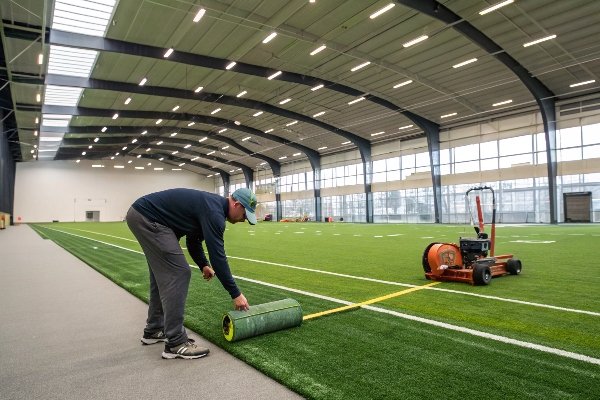
Sigue leyendo para ver mi guía paso a paso y más consejos.
¿Cómo se cortan los rollos de césped de gimnasio paso a paso?
Siga estos pasos: 1. Mida y marque. 2. Elija una herramienta afilada. 3. Corte líneas rectas. 4. Maneje las curvas o costuras con cuidado.
Mi guía paso a paso
He cortado suficiente césped para saber que un plan claro ahorra tiempo y material. Así es como lo hago yo:
- Medir y marcar: Mido el soporte con una cinta métrica, marcando ambos extremos con tiza. Trazo una línea de tiza para los cortes rectos o plantillas para las curvas.
- Elegir herramientas: Una navaja afilada sirve para la mayoría de los trabajos. Para céspedes gruesos, uso un cuchillo para alfombras. ¿Proyectos grandes? Un cúter eléctrico acelera el trabajo.
- Cortar líneas rectas: Fijo el césped en una superficie estable, sigo la línea de tiza y corto lentamente. Varias pasadas mejor que forzarlo.
- Curvas o costuras del asa: Para las curvas, utilizo plantillas y corto por secciones. Para las costuras, superpongo, corto ambas piezas juntas y recorto los mechones para conseguir una unión ajustada.
Este proceso sirve para cualquier tipo de césped, desde el de pelo corto hasta el acolchado.
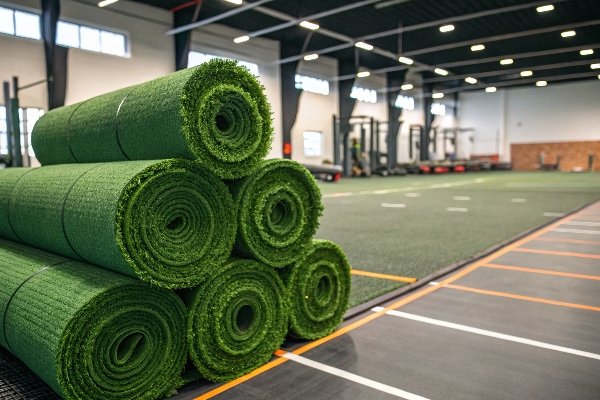
Consulta a continuación mis consejos de seguridad para evitar errores de novato.
¿Qué consejos de seguridad hay que seguir al cortar el césped del gimnasio?
Lleva guantes y gafas, asegura el césped, mantén alejados a los niños y utiliza una superficie estable para estar seguro mientras cortas.
Mantener la seguridad y evitar errores
He estado muy cerca de usar cuchillas afiladas, así que la seguridad no es negociable. Siempre llevo guantes antideslizantes y gafas para protegerme las manos y los ojos. Fijo el césped en una superficie plana y estable, nunca en una mesa tambaleante. Los niños y las mascotas permanecen lejos durante el corte. También cambio las cuchillas a menudo para evitar forzar los cortes, lo que provoca resbalones. He aquí cinco errores comunes que he visto:
| Error | Fijar |
|---|---|
| Hoja sin filo | Cambie las cuchillas cada 10-15 minutos |
| Dirección incorrecta de la fibra | Comprobar la alineación de las fibras antes de cortar |
| Medidas de apresuramiento | Mida dos veces, marque claramente |
| Superficie inestable | Utilizar una superficie plana y antideslizante |
| Costuras mal solapadas | Recorte tres mechones, utilice cinta de costura |
La seguridad y el cuidado mantienen su proyecto sin problemas ni lesiones.
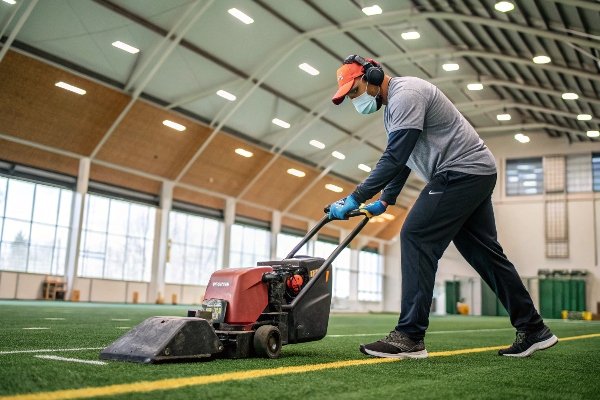
Siga leyendo para obtener consejos de corte ecológicos.
¿Cómo se puede cortar el césped de los gimnasios de forma sostenible?
Utilice cuchillas reutilizables, recicle los restos y elija herramientas ecológicas para cortar el césped con un impacto y unos residuos mínimos.
Cortar pensando en el medio ambiente
Intento que mis proyectos sean ecológicos, sobre todo cuando corto césped. Utilizo cuchillas con hojas reemplazables para reducir los residuos; marcas como Stanley ofrecen cuchillas reciclables. Los restos no van a la basura; guardo trozos pequeños para parches o los dono a recicladores locales. Algunas herramientas de 2025, como los cúteres eléctricos sin cable, son eficientes desde el punto de vista energético. Para marcar, utilizo tiza lavable en lugar de rotuladores permanentes. Si corto en tierra, coloco una lona para recoger los restos. Así es como soy sostenible:
| Práctica | Beneficio |
|---|---|
| Cuchillas reutilizables | Menos residuos, más rentable |
| Reciclaje de chatarra | Reduce el uso de vertederos |
| Herramientas ecológicas | Menor consumo de energía |
Reducir de forma inteligente ayuda al planeta y a tu bolsillo.
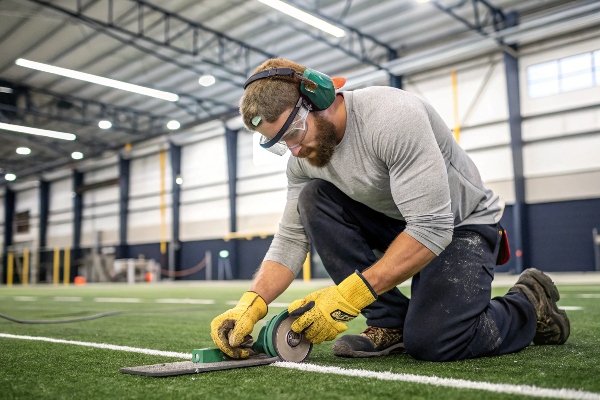
Siga adelante para obtener respuestas a preguntas habituales sobre el corte de césped.
¿Cuáles son las preguntas más frecuentes sobre el corte de césped de gimnasio?
¿Puedo utilizar tijeras? ¿Cómo se disimulan las costuras? ¿Cuánto tiempo se tarda? Aquí tienes respuestas claras a estas preguntas.
Respuestas a sus preguntas más frecuentes
Me preguntan mucho sobre el corte de césped, así que aquí van mis mejores respuestas:
- ¿Puedo utilizar tijeras normales? Las tijeras para trabajos pesados sirven para pequeños arreglos, pero son lentas y engorrosas para cortes grandes. Utiliza una navaja multiusos.
- ¿Cómo ocultar las costuras? Superponga el césped, corte ambas piezas juntas, recorte tres mechones por borde y utilice cinta de costura para una unión invisible.
- ¿Cuánto tarda? Un área de 10×10 pies requiere unos 30-60 minutos, dependiendo de las esquinas y curvas. Medir bien acelera las cosas.
Estos consejos proceden de la prueba y el error, para que no tengas que aprender por las malas.

Tabla comparativa de herramientas
| Herramienta | Pros | Contras | Precios | Lo mejor para |
|---|---|---|---|---|
| Cuchillo multiusos | Asequible y preciso | Necesita cambios frecuentes de cuchillas | $5-$20 | Recortes generales |
| Cuchillo para alfombras | Ideal para soportes gruesos | Menos versátil | $10-$30 | Césped resistente |
| Cortadora eléctrica | Rápido, bueno para grandes superficies | Caro, necesita energía | $50-$300 | Grandes proyectos |
| Tijeras para trabajos pesados | Fácil para pequeños arreglos | Lento, desigual para cortes grandes | $15-$25 | Reparaciones de bricolaje |
| Cortadora especial | Precisión profesional | Coste elevado, curva de aprendizaje | $80-$200 | Uso profesional |
